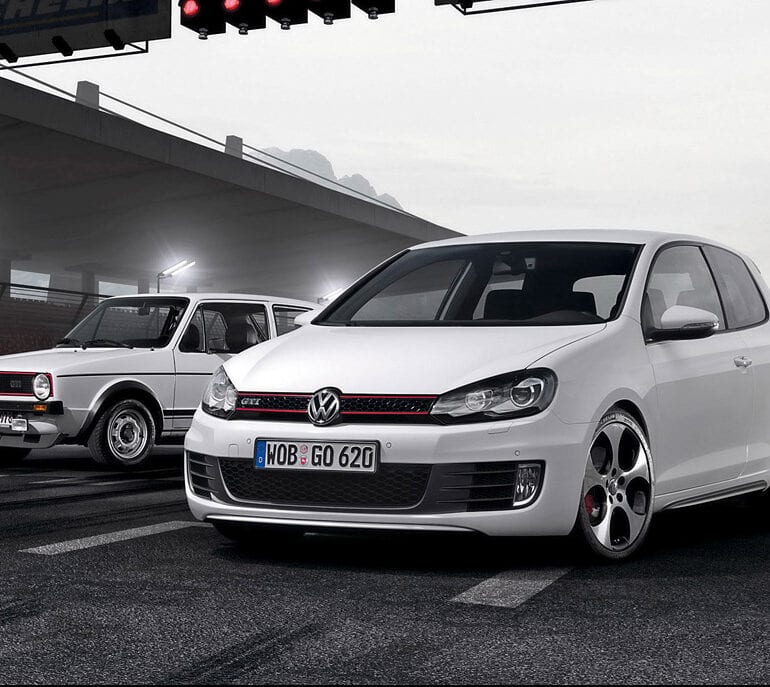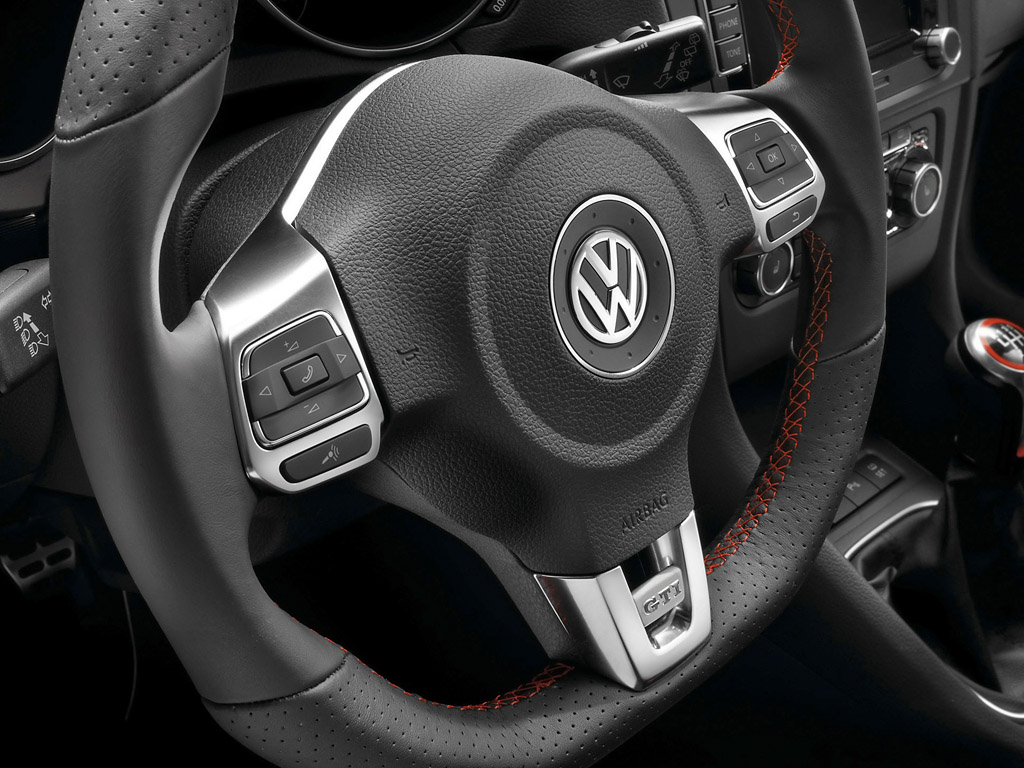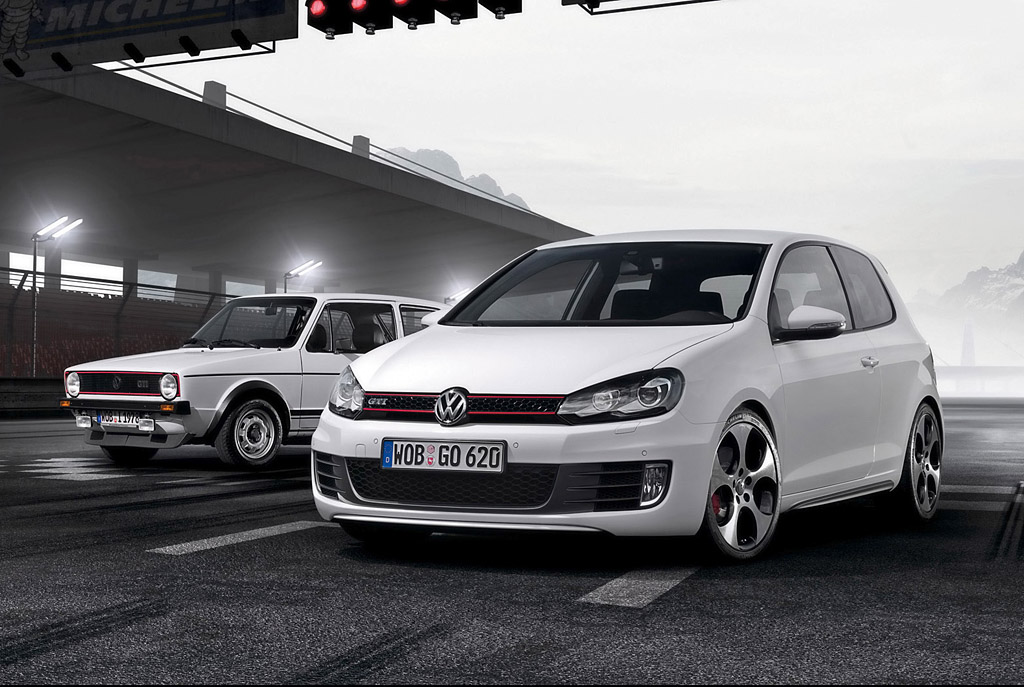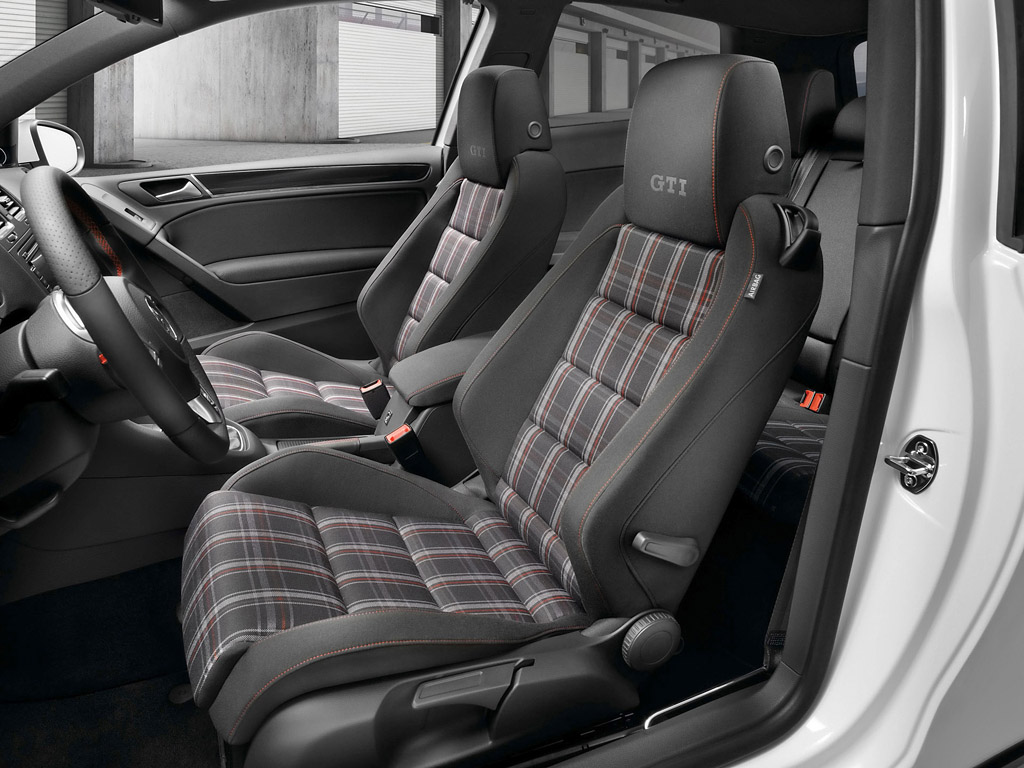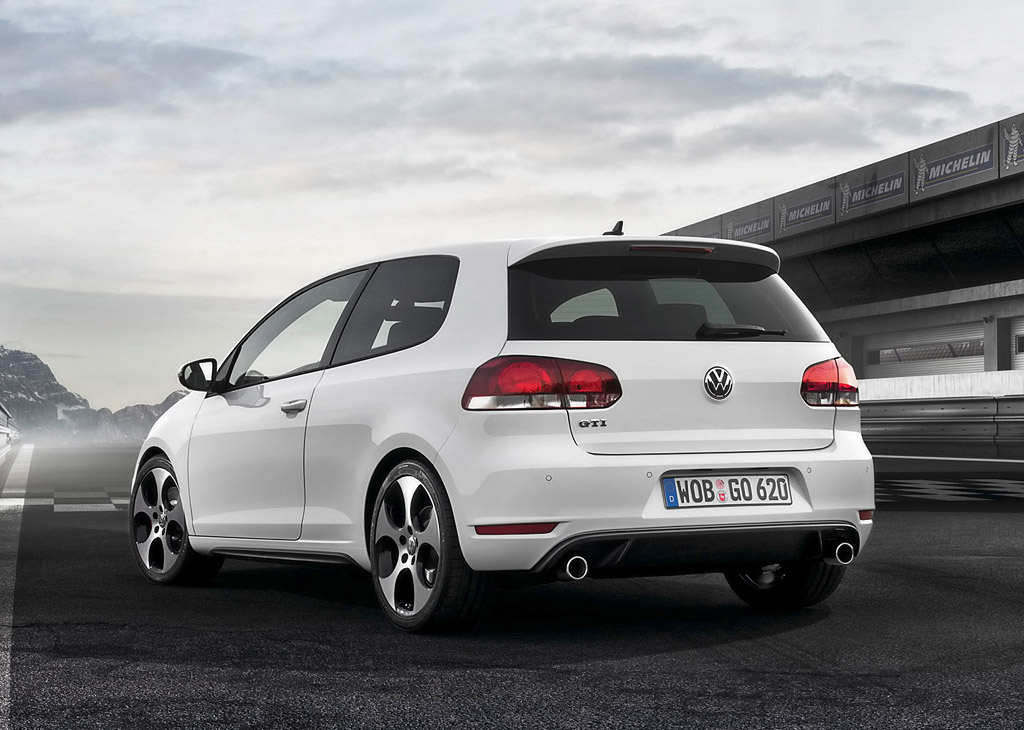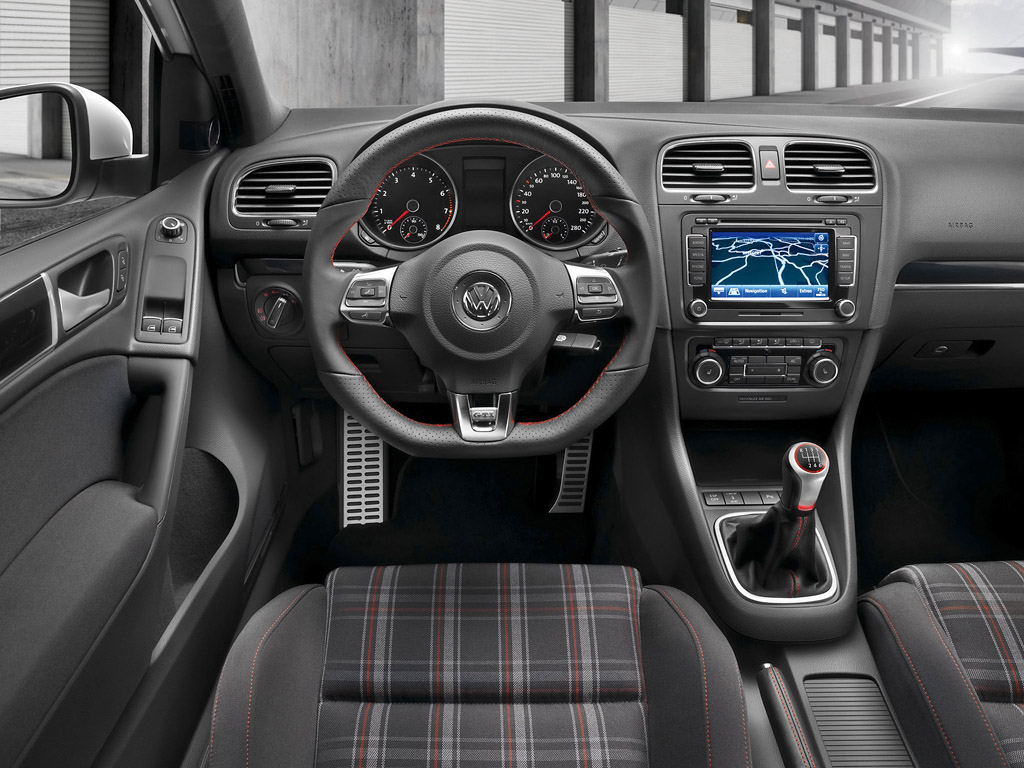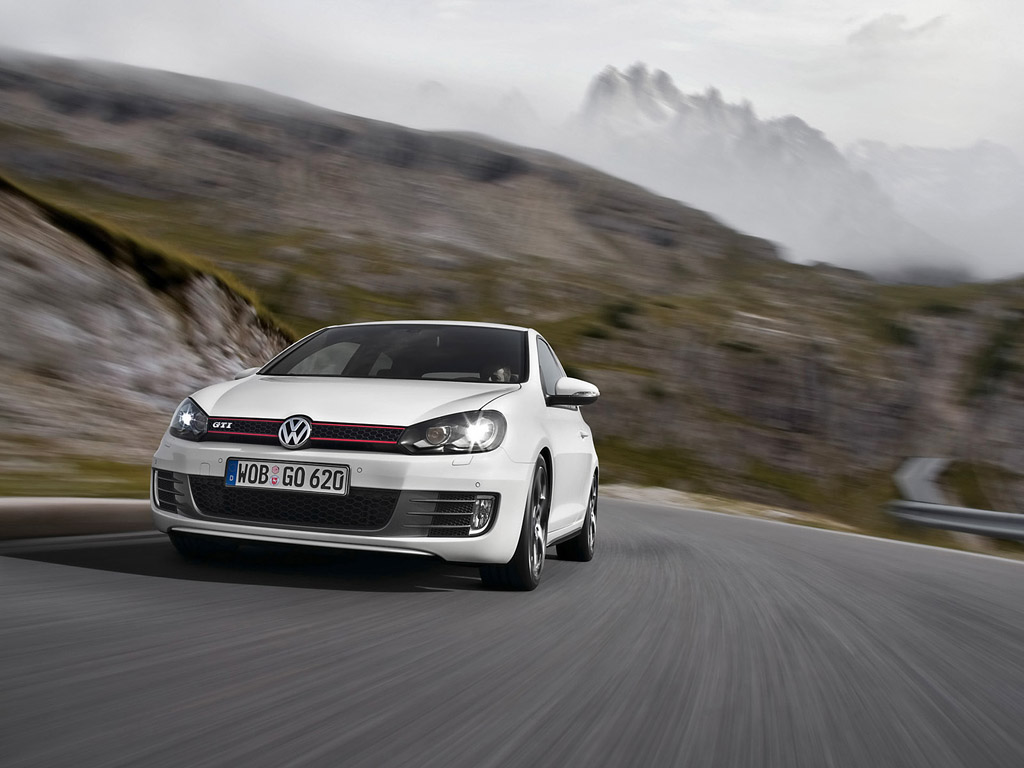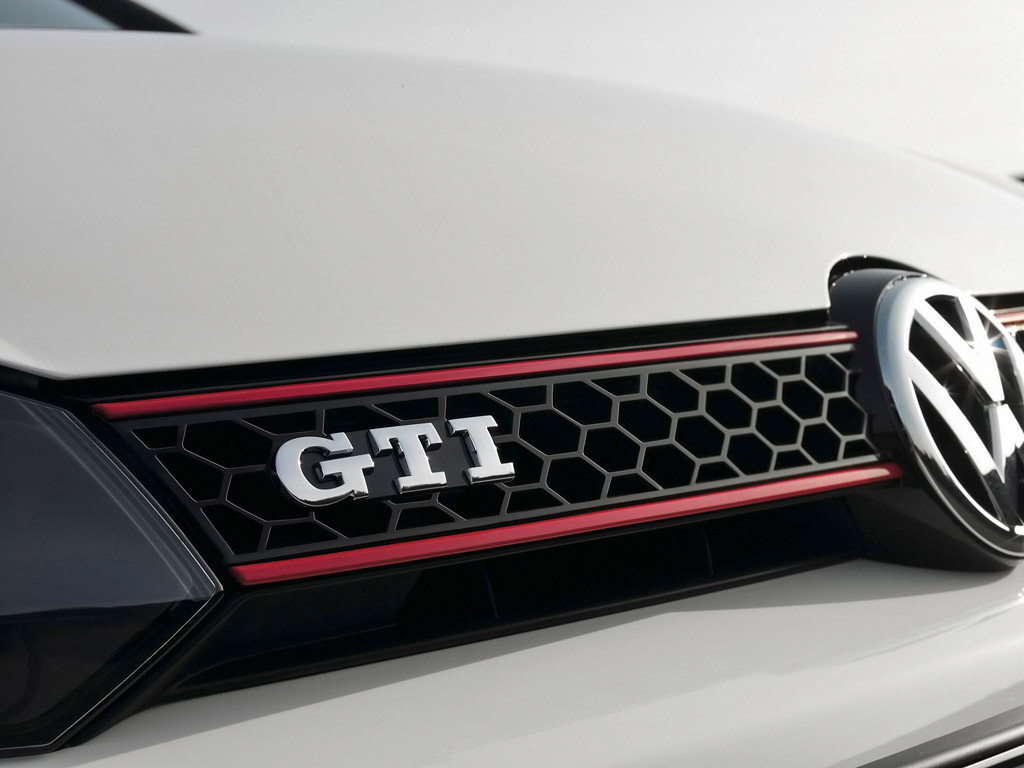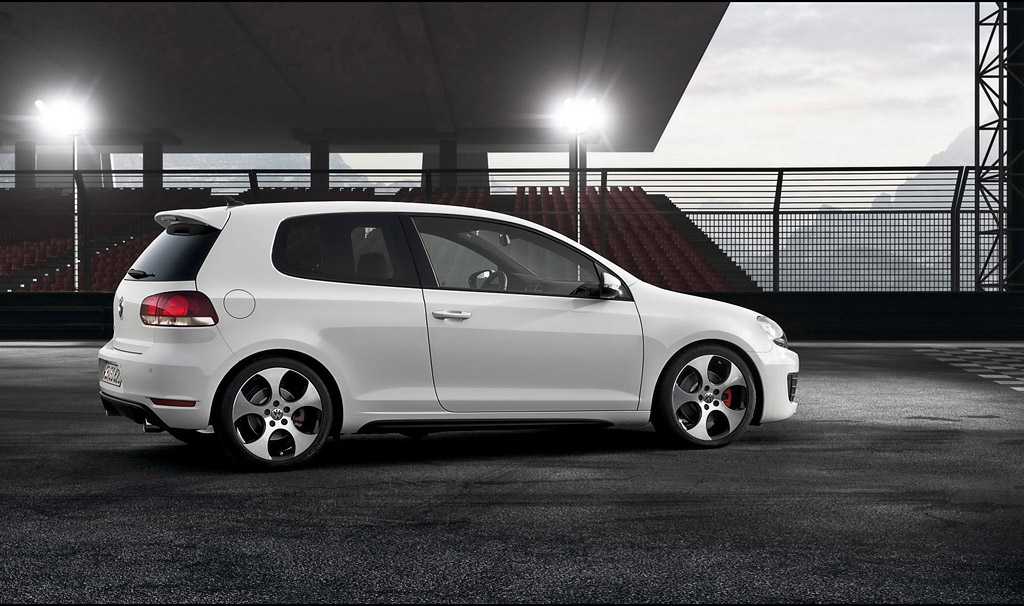Availble in Europe from 2009 and North America in 2010, the Mk6 GTI was available for in both a 5-door and 3-door configuration with either a 6-speed automatic or manual transmission.
The car is built on Volkswagen’s Group A5 (PQ35) platform which takes benefits from a fully-independent suspension.
Press Release
Wolfsburg / St. Tropez, 23 March 2009 – “What else was there in 1976?” calls out “Strietzel”, also known as Hans-Joachim Stuck, from the driver’s window as he starts up a first generation Golf GTI after more than thirty years. “Whenever a person had a chance to drive a 911, it was a real experience. And then all of a sudden this experience was possible in the GTI too. Clearly on a different level, but affordable for everyone. That was the genius of this car, and it has stayed that way right up to today. The new GTI is a prime example of this.” Stuck – one of the true giants of international car racing – works closely with Volkswagen AG. As a representative and driver in car racing, and as an expert in chassis and powertrain tuning in vehicle development, he also put the final touches on the new Golf GTI together with the experts of team “Hackenberg”. On the Nürburgring as well, where development chief Dr. Ulrich Hackenberg and Hans-Joachim Stuck competed in parallel, driving Sciroccos for glory and professional experience in last year’s 24-hour race.
Volkswagen is right at home on the Nürburgring’s North Loop. It has always been that way. And the GTI too. Even before sales of the GTI began, it was present on the track of the “Green Hell” before thousands of spectators in 1975 – as a pace car in the prototype stage with a two-barrel carburetor instead of electronic injection. The rest is history. Automotive history. “The 110-PS engine of the GTI”, recalls Stuck, “had a willingness to rev that was fun from day one. There had been nothing like it before. That is why the first GTI made such a statement.”
In 2004, the fifth Golf GTI brought back this legend more powerfully than ever before. Between the debut of the first generation and the production runout of the fifth generation, more than 1.7 million car buyers made the GTI a world bestseller. Now this is being followed up by the sixth GTI, even sharper and more confident than all of the others before it. A GTI whose chassis systems – with standard electronic transverse differential lock (XDS) – redefines behavior in curves and traction. A 240 km/h fast GTI that is more fun to drive with its powerful 155 kW / 210 PS turbo engine and yet only consumes 7.3 liters super unleaded (0.7 l/100 km improvement). A GTI that delivers audible dynamics with a sound generator and new exhaust system design (two tailpipes, one left and one right). A GTI that successfully transfers the tradition of the original version to the future.
German market launch of the sixth GTI will begin in just days. Sales start across Europe just after Easter. North America and Asia will follow in late summer – long ago the GTI success became an international phenomenon.
And Hans-Joachim Stuck (58) is more than just a figurehead of Volkswagen Motorsports and more than an expert who just looks for vehicle weaknesses. “Strietzel”, the nickname given to him as a baby by his godmother, and by which he is still called today by friends, is a GTI fan: “We always had a GTI in the family, from the first to the sixth. The Pirelli Editions too. There were no gaps here. Even when I was under contract with BMW, I preferred to drive to the Nürburgring in a GTI. It was in a GTI that I drove 911 drivers to distraction on the North Loop. My wife was even driving a GTI when she first caught my attention.”
Engine of the GTI
In the case of the Golf GTI generation VI, the fascination for Stuck began once again with the engine: “It is extremely important that the current GTI, like the last one, should be another turbo. This boosted high-tech engine fits in perfectly with our times. It is more fuel efficient than a large displacement engine, but thanks to the turbocharger it is just as athletic.” And that is a key aspect of the Golf GTI tradition too: As early as the second generation, the G60 had an impressive boosted four cylinder engine (118 kW / 160 PS). Later, the era of boosted GTI engines really gained momentum with the fourth generation in the “Golf GTI 132 kW” (the exact name). The technology and times were ready for this approach. A limited edition (3,000 cars) of the 132 kW / 180-PS version was introduced on the GTI’s 25th anniversary in 2001. Although there had already been a 150-PS turbo, it did not yet have the aggressive punch of the anniversary version. With the launch of the fifth Golf GTI, an entirely new turbocharged four-cylinder engine was employed, which delivered a power of 147 kW / 200 PS. On the 30th anniversary of the GTI, a 169 kW / 230 PS turbo engine was introduced in the Golf GTI Edition 30. Somewhat later, this new engine also powered the second Pirelli GTI.
At exactly 155 kW / 210 PS, in terms of power level the new Golf GTI’s TSI engine is positioned between the last production GTI and the 30 Year Edition. Although its performance and displacement data might suggest an advanced development of the 200-PS engine, this was actually a new powerplant of the “EA888” generation of engines whose technical origins were in the 230-PS version.
The TSI that is used in the sixth GTI is a product of the second development stage of these highly agile engines. Compared to the first “EA888” development stage, this engine – optimized for transverse mounting in the new GTI – has new components such as modified pistons and piston rings, a regulated oil pump, a new vacuum pump, a new high-pressure fuel pump and a new mass airflow sensor. When used in the most powerful Golf today, the engine fulfills limits of the Euro-5 emissions standard.
Performance of the GTI
When it comes to emissions and fuel economy, the new 210-PS engine has advanced far ahead of the two previous GTI four-cylinder engines with 200 and 230 PS. To be specific, the 1,984 cm3 displacement TSI on the new GTI is content with just 7.3 liters fuel per 100 kilometers on average. On the 200-PS GTI, fuel consumption was 8.0 liters, and the 230-PS GTI came in at 8.2 liters per 100 kilometers. So the theoretical range of the sixth GTI is about 750 kilometers between fill-ups.
At 170 g/km, the engine also shows marked improvement in CO2 emissions. “And the new GTI,” says Hans-Joachim Stuck, “succeeds in bridging the gap between a serious business car during the work week, and a competitor on the Nürburgring on the weekend.” In this context, it should be noted that the first Golf GTI in 1976 had a power of exactly 81 kW / 110 PS and a top speed of 182 km/h, and at that time it was also one of the few cars to perform this balancing act.
The new GTI successfully addresses these aspects while attending to the property of most interest to GTI buyers – besides the car’s appearance – which is its dynamic performance. At a low 1,700 rpm the engine already develops its maximum torque of 280 Newton-meter. And this reserve torque is available as a constant value – exhibiting an ideal plateau in the torque curve that is not really a curve any longer – up to 5,200 rpm. Stuck says: “In practice, this means impressive power in all of life’s situations.” The maximum power of the sixteen-valve engine with 9.6:1 compression ratio can be tapped over a speed range from 5,300 to 6,200 rpm.
The resulting package delivers enormous propulsive force; the car completes its acceleration from 0 to 100 km/h in just 6.9 seconds, and the new Golf GTI handles a 1,000 meter sprint from a standstill in 27.3 seconds. Just as impressive is the engine’s elasticity. In fifth gear, the Volkswagen accelerates from 80 to 120 km/h in just 7.5 seconds. Even in sixth gear it only takes 9.5 seconds. Not until 240 km/h is a balance reached between air resistance (cw = 0.324) and power. The tachometer indicates 5,900 rpm at this top speed.
Like the previous model, for the new GTI an optional 6-speed dual clutch transmission (DSG) will be offered as an alternative to the 6-speed manual transmission (including standard upshift recommendation as on the BlueMotion). In this case, the Golf delivers a top speed of 238 km/h (at 5,920 rpm). Like the manually shifted GTI, the DSG version also accelerates to 100 km/h in 6.9 seconds. Its average fuel consumption of 7.4 liters (173 g/km CO2) nearly matches the excellent value of the manual transmission (7.3 liters).
Yet the numbers themselves only tell half of the story about the dual clutch transmission. Stuck: “The DSG is incredibly fast and precise. And the way in which the Golf GTI with DSG automatically double declutches when downshifting is a joy for any sports car driver. Interesting is the fact that the pedal position on the very first GTI, and of course also on the normal Golf, was laid out so that well-versed car drivers could double declutch properly.” According to forecasts, about 30 percent of all GTI drivers will order the sporty Volkswagen with DSG.
Sound of the GTI
The engine and exhaust system of the new Golf GTI are making their appearance with an entirely unique and typical GTI sound. A sound that makes a very sporty impression yet does not irritate car occupants on long tours. On the exterior, the noise level is fully regulated by the newly developed GTI exhaust system. The only visible components of the exhaust system are the pair of chrome tailpipes integrated in the GTI’s black diffuser, one on the left and one on the right. Inside, a complex exhaust routing system produces the typical GTI sound. In parallel, it was possible to reduce the weight of the system and its back pressure. And that has a direct positive impact on driving performance and fuel economy. Moreover, a sound generator ensures that the sonorous engine acoustics are perfectly “mixed” in the car’s interior as well.
Chassis of the GTI
“Physical handling limits” always come into play when the safety reserves of a chassis need to be determined. The actual boundaries of the new Golf GTI’s physical handling limits are revealed when a driver like Hans-Joachim Stuck is at the wheel. Just a few laps in Hockenheim or on the Nürburgring or a few kilometers in the “Maritime Alps” on the mountain roads above Nice are sufficient for the former Formula-1 driver and endurance race world champion to very analytically describe why the Golf GTI drives at the level of significantly more expensive sports cars and – this is crucial – can also excite the drivers of such extremely expensive sports cars.
Stuck: “It becomes immediately apparent just how precisely the GTI tracks steering inputs. And this steering precision is directly reflected in driving quality. The production car chassis offers practically no hint of body roll. The car’s quasi lack of roll and pitch results in very safe driving behavior. However, the GTI not only handles with sports car stiffness; it is also very comfortable. The electronic damper control of its new DCC system, in particular, produces an ideal synthesis of great comfort and excellent handling properties in the GTI. There are of course many sporty cars that are simply too stiff. Yet this one is always right. That must be stated very clearly.”
The sixth Golf GTI is equipped with a sport chassis; its front end was lowered by 22 millimeters, and its rear by 15 millimeters. The entire architecture of springs, dampers and rear stabilizers was completely re-tuned. In front, the familiar strut-type suspension operates with helical springs and telescoping shock absorbers. In the rear, an innovative multi-link suspension ensures that the ESP system seldom needs to intervene. The braking system is also extremely durable. Distinctive here are the red painted brake calipers.
Sportier and safer with XDS
For the first time in a Volkswagen, the XDS electronic transverse differential lock is being used. It significantly improves traction and handling properties. Technically speaking, XDS is a functional extension of the electronic limited-slip differential (EDS) integrated in the ESP system.
In fast curve driving, as soon as the innovative electronics detects that the wheel at the inside of the curve on the GTI’s driven front axle is insufficiently loaded, the ESP hydraulics specifically builds up braking pressure at this wheel to restore optimal traction. So XDS acts as a type of transverse differential lock that compensates for the understeering that is typical on front-wheel drive vehicles when driving fast through curves.
The results: Thanks to XDS, driving behavior is significantly more precise and neutral; drivers perceive this as more like the handling characteristics of a car with all-wheel drive than those of front-wheel drive. Hans-Joachim Stuck: “Beyond the GTI’s already good chassis layout, XDS gives the car an enormous measure of driving stability. And it leads to greater driving enjoyment, since it reduces understeering. Experienced sports car drivers will be much more active underway. Yet, XDS is a very important safety feature for normal drivers too, because they will not experience any unpleasant surprises with the GTI. It simply would no longer press ahead.”
Dynamic yet comfortable with DCC
In addition, the dynamic chassis control (DCC) system mentioned by Strietzel is available on the new GTI. It continually reacts to the roadway and driving situation and modifies the damper characteristic accordingly. The driver perceives the significant advances in comfort and dynamic performance directly. During acceleration, braking and steering actions, damping is stiffened in just fractions of a second to optimally satisfy vehicle dynamic requirements and reduce pitch and roll movements as described by Stuck.
To let drivers choose the desired system behavior, besides the “Normal” program with a basic medium setting, DCC on the Golf GTI also offers the “Sport” and “Comfort” modes that are activated by a pushbutton above the shift gate. In “Sport” mode, the power steering is also tuned for greater dynamic responsiveness.
Cruising safely with ACC
For the first time, the distance control system ACC (Adaptive Cruise Control) will be offered on the Golf GTI starting in late summer 2009. When ACC is activated, the system automatically brakes and accelerates the GTI within a speed window from 30 to 210 km/h. Above all, when cruising at constant speed, e.g. at the speed limit on the freeway, ACC offers a significant plus in comfort and safety.
Distance control is implemented with a laser sensor in the rearview mirror that continually scans the distance to the vehicle in front of the car and its speed using five laser beams. The system operates successfully in curve driving too. ACC is controlled via a lever on the steering column. Important: As soon as the ACC system reaches its limits, the driver is asked to resume control by visual and acoustic warning signals.
Park Assist Generation II
Another high-end technology on the new Golf GTI is the optional Park Assist park steering assistant. The second generation of the system is used here. It enables nearly automatic back-up parking parallel to the roadway. The driver just needs to actuate the gas pedal, brake and (in the manually shifted version) clutch, while the GTI steers into the pre-scanned space by sensor control. Previously, the space had to be at least 1.4 meters longer than the vehicle; now 1.1 meters is sufficient. In addition, the system now enables multiple forward-reverse stages in parking. Park Assist deactivates itself as soon as the driver manually intervenes in steering. When the GTI is ordered with this system, the acoustic proximity warning system ParkPilot (front and rear) and Hill Hold Control are included too.
Bi-xenon headlights with curve lighting
As an option, Volkswagen is offering the Golf GTI with completely redesigned bi-xenon headlights, including dynamic curve lighting. The headlights swivel through a steering radius of up to 13 degrees to the outside and seven degrees to the inside. The styling of the headlights closely matches the GTI’s sporty character. The interior dual modules (xenon outboard, parking light / turn signals inboard) each have a chrome pod through which a very impressive visual image projects. Placed low below the bumper – and also GTI-specific in design – are the vertically aligned and always standard front fog lights.
Interior of the GTI
If there is such a thing as total ergonomic perfection, then it is to be found in the new GTI. Stuck: “This ambiance lacks nothing that a person would have in a luxury sedan. Nonetheless, the interior is uncompromisingly sporty. This begins with the seats. They offer a high degree of long touring comfort and are equally fit to run a 24-hour race. The GTI is super comfortable, super ergonomic. You can adjust everything on the seat. But there is no need to. You just climb in, move the seat forward once then back, and that is it. Sit down. Done. A perfect fit.” A genuine compliment.
The Golf GTI is equipped with standard sport seats, which – as once before – are upholstered in a tartan fabric pattern (“Jacky”). Leather seats (“Vienna”) are available as an option. A lumbar support integrated in the seats is positioned by a lever on the side of the seat. For safety, whiplash-optimized head restraints (WOKS) are also on board. The head restraints precisely counteract whiplash in case of an accident. The GTI logo has been worked into the WOKS material.
Additional features: Naturally, this Golf also has pedals with brushed stainless steel caps, a customized GTI gearshift lever in aluminum look, a leather steering wheel with grip recesses and GTI emblem; naturally there are decorative red seams on the steering wheel, gearshift surround and leather parking brake grip; naturally the roofliner is black, and so is the pillar trim. Naturally, because this Golf is a GTI. That is why the decorative inserts in the doors and instruments are also customized with “Black Stripe” style elements – black, high-gloss accents in metallic look. In any case, the GTI breaks through class boundaries with its high-end surfaces and features that are pleasing to the touch and the eye. The impression made by the materials and their workmanship, details like brushed chrome accents and elegant round instruments give the impression of actually sitting in a car of the next higher class, or in a far more expensive sports car. In contrast to most sports cars, however, the Golf GTI offers ample space for five persons. Its cargo capacity of between 350 and 1,305 liters also ensures that GTI drivers can handle nearly all of the challenges of daily life with confidence.
In Detail
| type | Series Production Car |
| built at | Wolfsberg, Germany |
| price $ | $ 23,890 |
| engine | CCZA Inline-4 |
| position | Front Transverse |
| aspiration | Turbocharged |
| block material | Cast Iron w/Aluminum Alloy Cylinder Head |
| valvetrain | DOHC, 4 Valves per Cyl, VVT |
| fuel feed | FSI Direct Injection |
| displacement | 1984 cc / 121.07 in³ |
| bore | 82.5 mm / 3.2 in |
| stroke | 92.8 mm / 3.7 in |
| compression | 9.6:1 |
| power | 154 kw / 206.5 bhp @ 5300 rpm |
| specific output | 104.08 bhp per litre |
| bhp/weight | 138.5 bhp per tonne |
| torque | 280 nm / 206.5 ft lbs @ 1700 rpm |
| body / frame | Volkswagen Group A5 (PQ35) Unitary Steel Monocoque |
| driven wheels | FWD |
| curb weight | 1491 kg / 3285 lbs |
| transmission | 6-Speed Manual or Optional DSG Automatic |
| top speed | ~209.17 kph / 130 mph |
| 0 – 60 mph | ~6.6 seconds |
| 0 – 100 mph | ~16.2 seconds |
| 0 – 1/4 mile | ~15.0 seconds |
| city fuel econ epa | 9.80 L/100 km or 24 mpg-us |
| hwy fuel econ epa | 7.59 L/100 km or 31 mpg-us |
Story by Volkswagen AG
Above Images ©Volkswagen AG


